Influence of Buffer Foam on the Swelling Thickness and Swelling Force of the Cell Charge and Discharge Process
Lithium-ion battery is an electric-heat-force coupling system, which has swelling problems in the actual use process. On the one hand, the SEI film is formed, and the air pressure inside the battery increases, and the thickness of the SEI film increases, thus causing the swelling of the cell; on the other hand, Li+ is charged and discharged The embedding and removal between the positive and negative electrode materials will cause a structural phase transition, which leads to the swelling phenomenon, which is mainly reflected in the change in the direction of the negative electrode sheet thickness.
The swelling behavior of lithium-ion battery is closely related to its reliability and safety. In the process of laboratory research, two parameters of swelling force and swelling thickness are usually used to evaluate the change of the swelling behavior of the battery in the charge and discharge process. The irreversible stress inside the battery also accumulates with the charge and discharge. Studies have been shown that Li+ during charge and discharge Diffusion impedance will increase with the increase of irreversible stress, but the appropriate stress increase can reduce the loss of active lithium, thus reduce the decay rate of cell cycle capacity, battery research and development process analysis of the change of the expansion performance, for the assembly of the appropriate assembly pressure has an important guiding significance.
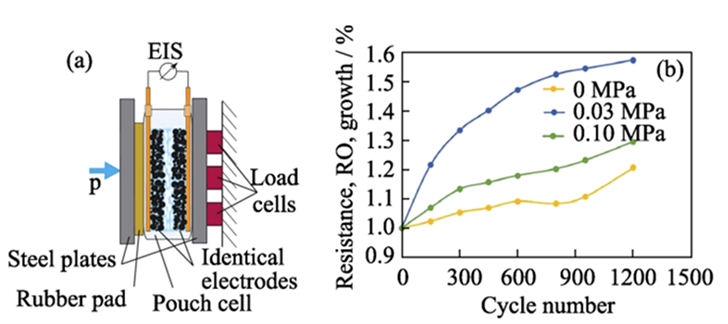
Figure 1 (a) shows the experimental principles of the reported external constraints and EIS tests¹; (b) The change of impedance under different external pressures²
More and more studies have shown that increasing buffer substances between batteries when installing a lithium-ion battery assembly can effectively reduce the expansion force of the battery and improve the electrochemical performance of the module. This paper chooses a silicone foam to increase the change of the cell swelling force and swelling thickness before and after the foam.
Experimental Equipment and Test Methods
1.Experimental Installation
1.1 In-situ swelling analyzer, model SWE2110 (IEST), equipment, appearance as shown in Figure 2.
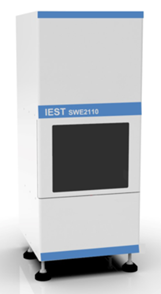
Figure 2. SWE2110 Equipment Appearance Diagram
2.Test Process
2.1 The Cell Information is Shown in Table 1
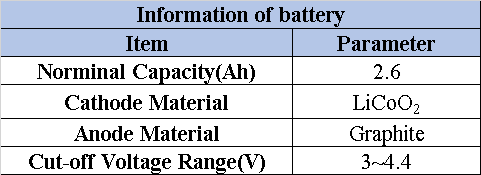
Table 1. Test cell Information
2.2 Charge and Discharge Process: 25℃, 2A charge and discharge, cycle for 5 laps.
2.3 Cell Thickness Swelling Test: Put the battery to be tested into the corresponding channel of the equipment, open the MISS software, set the corresponding cell number and sampling frequency parameters of each channel, and the software will automatically read the cell thickness, thickness change, test temperature, current, voltage, capacity and other data.
2.4 Test Process: 5100kg constant pressure cycles for the same battery, 100kg; 100kg for 2mm foam and 100kg for 5 times. Figure 3 shows the diagram of foam and actual test situation.
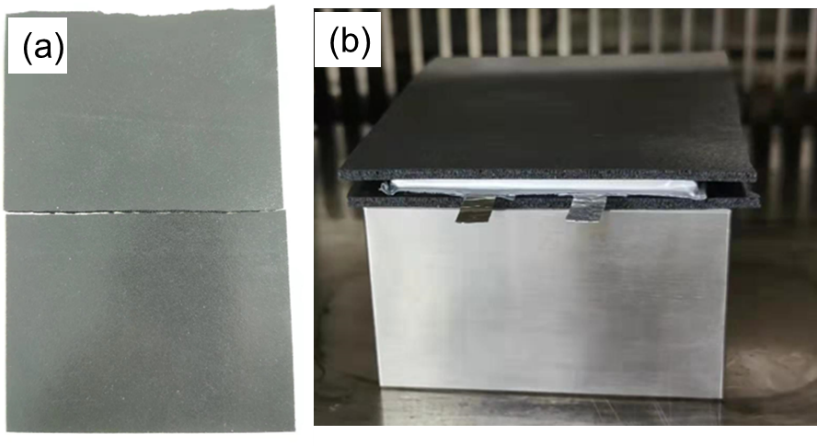
Figure 3 (a) Use of foam for test; (b) Schematic diagram of placement of foam for test
Analysis of Test Results of Swelling Thickness & Swelling Force
1.Swelling Thickness and Swelling Force Change During Charge and Discharge
In the study of the swelling behavior of lithium-ion battery, the change of the swelling thickness and swelling force in the process of constant pressure mode or constant gap mode is usually evaluated, where the constant pressure mode monitors the change of the cell swelling thickness, and the constant gap mode monitors the change of the cell swelling force. This paper mainly combines the constant pressure and constant gap experimental mode of SWE series in-situ swelling analysis system, respectively monitor the change of the swelling thickness and swelling force under the charge and discharge cycle, and clarify the influence of foam on the swelling thickness and swelling force in the charge and discharge process.
Figure 4 for constant pressure and constant gap under the condition of charge and discharge process of foam swelling thickness and swelling force change curve, from the curve results, the different test mode and foam charging and discharging process, the swelling thickness and swelling force change trend is the same, will present the charging swelling thickness or swelling force increases, discharge decrease phenomenon, but for a single mode, whether the absolute swelling thickness or swelling force is different.
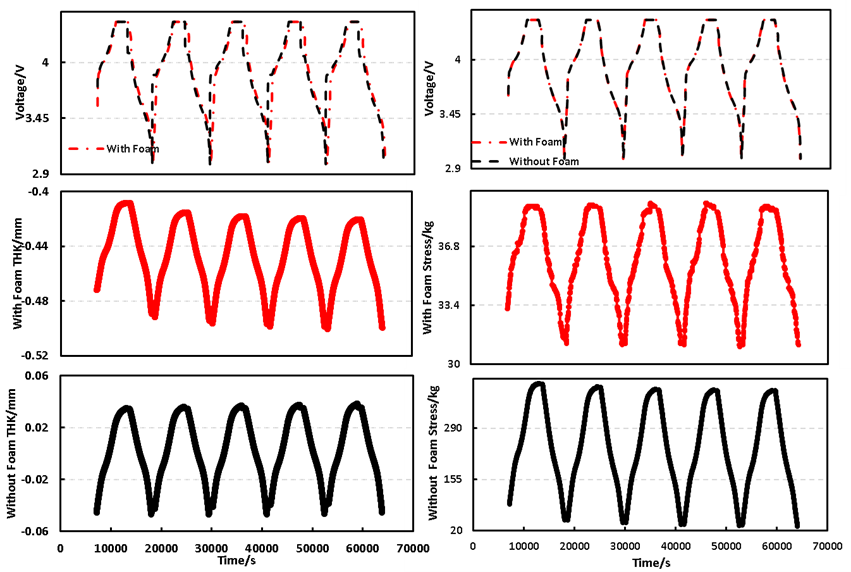
Figure 4. Swelling thickness and swelling force change curve of foam in the charge and discharge process under constant pressure & constant gap
To further clarify the influence of foam on the swelling behavior of the charging and discharge process, summarize the data of swelling thickness and swelling force in the two test modes, such as Table 2 summarizes the specific data of the swelling thickness and swelling force test results in each cycle, where the maximum thickness or swelling force change corresponds to the charging end of each cycle, the minimum thickness or swelling force change corresponds to the discharge end of each cycle, and the maximum and minimum of the difference is the corresponding amount of swelling thickness or swelling force change under each cycle. The 100kg constant pressure test results can be obvious, whether foam, the maximum swelling thickness and the absolute value of the minimum swelling thickness has obvious difference, this difference is mainly related to the thickness of foam after stress, the subsequent can combine with different constant pressure experiment and cell changes for further analysis, but the two tests of battery total swelling thickness difference is not big, this shows whether foam, does not affect the battery lithium behavior and positive and negative electrode structure swelling.
However, the swelling force test results in the constant gap test mode of 100kg initial pretension force show that, The test results of the maximum swelling force, the minimum swelling force and the total swelling force change under the foam condition are less than that of the no foam condition, From this, it can be analyzed that, Under the same pretension conditions, Compared to the battery with a harder stainless steel material contact, Using the foam buffer material with small hardness, Can effectively inhibit the swelling force in the battery during the charge and discharge process, This is in line with the reported results, For the same battery under the same test conditions, The amount of inflation produced can be considered constant, Battery swelling squeefoam, The action of the forces is mutual, Cotton also has a reaction force on the battery, The reaction force also forces the battery, To resist the swelling of the battery, The foam with a small hardness has a small reaction force, The extrusion degree of the battery is relatively small, The internal stress of the battery can be released to some extent by squeezing the foam, So the swelling force is small.
Table 1.The test results of the swelling thickness and swelling force of each cycle with and without foam.

It is reported that the appropriate mechanical pressure to the battery, can effectively shorten the path of Li + migration, reduce the loss of Li + to improve the service life of the battery, but the negative material layer spacing reduction, van der Waals force between layer, thus increase the resistance of Li + out, capacity reduction, subsequent can be combined with the same foam material different pretension force size and long cycle test from a deeper mechanism analysis.
2.Comparison of Differential Capacity Curve and Swelling Thickness and Swelling Force Curve
Figure 5 shows the charge-discharge differential capacity curve, swelling thickness and thickness, and force change curve of the cell, Where (a) and (b) are in the constant pressure mode, Schematic diagram of swelling thickness changes and charge-discharge differential capacity curves, In (c) and (d) in constant gap mode, Schematic diagram of swelling force change and charge-discharge differential capacity curve, As can be seen from the figure, For this LCO system battery, The inflection point of the swelling thickness or the swellingn force change during charging can correspond to the phase change peak of the positive and negative electrode lithium embedding, It is further clarified that the swelling effect of the battery in the charge and discharge process is mainly related to the structural phase change caused by the positive and negative electrode embedding and the lithium process. Under the condition of short-term cycle, whether there is foam and constant pressure constant gap different measurement mode, the two variable conditions on the peak of the differential capacity curve and cell capacity is little affected, but if considering long-term cycle conditions, may have greater influence on cell capacity attenuation, subsequent can be combined with specific test results for further analysis.
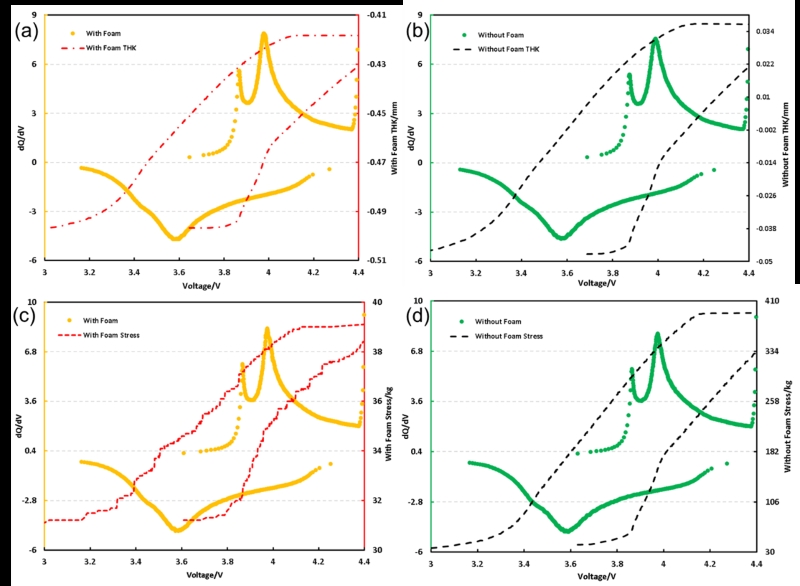
Figure 5.Differential capacity curve, swelling thickness curve and swelling force change curve under foam condition
Sum Up
In-situ swelling analyzer (SWE) is used to analyze the swelling thickness and swelling force of LCO system without foam, It was found that during the charge and discharge process, The trend of swelling thickness and swelling force are the same, It is mainly related to the structural phase change in the process of charge and discharge; The comparison results with and without foam showed that, The difference between the swelling thickness and the swelling force, This is mainly due to the effect of buffer foam hardness on swelling, Using this experiment as an example, Lithium battery research and development workers can combine the test system for different materials and stress and strain curve buffer foam screening, It provides a new idea for the pretension force evaluation of the cell module.
Reference Material
1.SAUERTEIG D, HANSELMANN N, ARZBERGER A, et al. Electrochemical-mechanical coupled modeling and parameterization of swelling and ionic transport in lithium-ion batteries. J.Power Sources, 2018, 378: 235–247.
2.BARAI A, TANGIRALA R, UDDIN K, et al. The effect of external compressive loads on the cycle lifetime of lithium-ion pouch cells. J. Energy Storage, 2017, 13: 211–219.
3.Influence of foam performance of Qiu itao, Chen Chaohai and Jiang Jibing on the expansion force of battery module [J]. Guangdong Chemical Industry, 2020,47 (22): 3.
4.Wang Yanan, Li Hua, Wang Zhengkun, and the research progress on the failure mechanism of isodiffusion stress-induced lithium-ion batteries [J]. Journal of Inorganic Materials, 2020,35 (10): 17.
